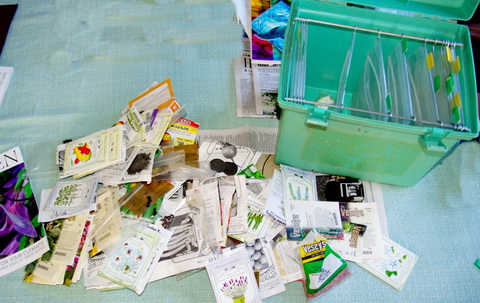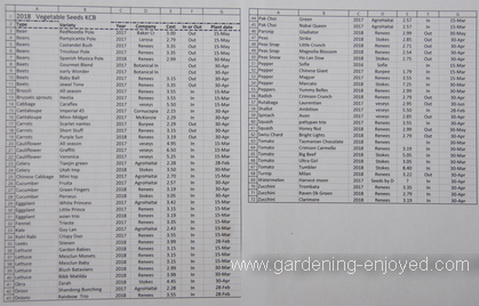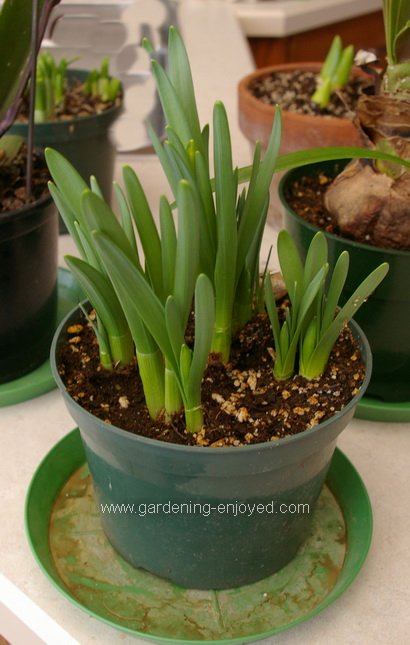
It was February and the weather was not conducive to skiing and we needed to do something garden like. Pulled out the seed storage box and dumped its contents on the dining room table and began to sort. We were not sorting by variety or type but rather by date. Seeds vary greatly in how long they stay viable. Parsnips must be grown from very fresh seed but Tomato seed that is ten years old will still germinate fairly reliably. Knowing the viability of all the things I grow is just too much information to store in my aging brain so we get ruthless and toss out anything that is older than last year. If the seed packet said sell by 2016 or older it was eliminated. Being a studious recycler, each packet was opened and the seeds dumped into a compost bowl and the paper packet into the recycling bin. That leaves you with an interesting bowl of multi coloured and multi sized seed and part of me want to throw all of it onto some wet soil or paper towel and see what comes up.
Common sense eventually prevails and it gets dumped into the compost. Now I have lots of empty spaces in the seed storage box to fill with new acquisitions. Having a few moments to spare I did something, at least for me, quite radical, I decided to actually make a written list of what I had so that I could better work the seed catalogues to make sure that I was buying what I actually wanted or needed. Record keeping has never been one of my strong suits. I have a few copies of gardening record books that are filled out for a month or so and then abandoned. As the old mental record system ages I seem to find it less reliable and thus the seed spreadsheet.

70! That’s the number of entries that you can see on this spreadsheet. That’s about 34 different vegetables and we get to 70 because we must have 4 varieties of Tomatoes and 5 of Peppers and you get the idea. I must pause and give the Assistant Gardener a credit here. I was struggling to find a way to save this spreadsheet so that I could put it into “Dallying” and she said, ’Why don’t you just print it and take a picture?” Of course, why didn’t I think of that? By creating the spreadsheet I was able to easily do some other interesting things like total the cost column. It comes to $220. Now that may seem like a lot of money to spend on seeds but lets look at the outcome. We eat several fresh organic vegetables almost every day from the end of April until almost the end of November and that’s about 220 days. What a bargain at $1.00 per day. It’s
even better when you realize that half of those seeds where left over from last year so we actually only spend 50 cents a day to eat very well. Of course there is some water and some fertilizer to add in there but they are not significant costs. Like most gardeners, we supply the labour at no cost because all of that time in the garden is a net benefit to our bodies and souls and not a cost.
 Now that we are nearing the end of February it’s time to find our way into the back corner of the cold room. In behind the wine racks there are a number of pots sitting on the floor with little green shoots emerging. The miniature Narcissus that we potted up in November have had their winter’s sleep and it’s time to start bringing them up to the light and warmth to fill the house with their bright yellow bursts of spring colour. Each year when I finally talk myself into potting up those bulbs I wonder if it’s all worth the effort and as soon as the first bloom opens on a cold dark February day I know the answer.
Now that we are nearing the end of February it’s time to find our way into the back corner of the cold room. In behind the wine racks there are a number of pots sitting on the floor with little green shoots emerging. The miniature Narcissus that we potted up in November have had their winter’s sleep and it’s time to start bringing them up to the light and warmth to fill the house with their bright yellow bursts of spring colour. Each year when I finally talk myself into potting up those bulbs I wonder if it’s all worth the effort and as soon as the first bloom opens on a cold dark February day I know the answer.
Now it’s time to answer a few of my reader’s questions. To ask a question just “reply” to this ezine. Don’t forget to check the front page of the Website for
frequent short ideas for current gardening activities.
Krystyna Asks? thank you for your wonderfully informative newsletters, always a joy to receive. I have one question though; how do you encourage your Epiphyllum Cactus to bloom, mine never has , it's been a just prickly cactus indoors and outdoors for me :-)
Ken Answers! I really wish that I had some secret technique for blooming Epiphyllum. The reality is I just move it in and out with the seasons, shady location outside, water it regularly and fertilize it occasionally when it's outside and it sporadically decides to bloom. I found this web site with way too much information but valuable.
Julia Asks? I have begonia tubers and a Canna Lily in brown bags in the basement. When do you start these ones indoors, or can you just plant them outside in June?
Ken Answers! I
usually start those indoors about mid March. The Begonias a bit ahead of the Cannas. You could plant them outdoors late May but you wouldn't see any blooms until very late in the summer.

 Now that we are nearing the end of February it’s time to find our way into the back corner of the cold room. In behind the wine racks there are a number of pots sitting on the floor with little green shoots emerging. The miniature Narcissus that we potted up in November have had their winter’s sleep and it’s time to start bringing them up to the light and warmth to fill the house with their bright yellow bursts of spring colour. Each year when I finally talk myself into potting up those bulbs I wonder if it’s all worth the effort and as soon as the first bloom opens on a cold dark February day I know the answer.
Now that we are nearing the end of February it’s time to find our way into the back corner of the cold room. In behind the wine racks there are a number of pots sitting on the floor with little green shoots emerging. The miniature Narcissus that we potted up in November have had their winter’s sleep and it’s time to start bringing them up to the light and warmth to fill the house with their bright yellow bursts of spring colour. Each year when I finally talk myself into potting up those bulbs I wonder if it’s all worth the effort and as soon as the first bloom opens on a cold dark February day I know the answer. 
